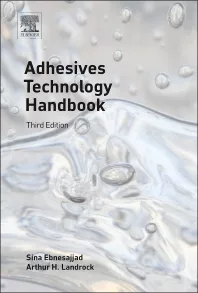Advancing Adhesives: Improving Hot-Melt Adhesives
A new generation of polyolefins with valuable properties has been introduced.
Polyolefin-based, hot-melt adhesives have proven their advantages in various fields of adhesive applications in recent decades. In the last 10 years, a new
| Jump to: |
generation of polyolefins have been introduced, showing new and value-adding properties for the hot-melt adhesive customer. This trend continues and will expand further with the continuous innovation of metallocene-based polyolefin grades showing new properties and behaviors.
As a global leader in polyolefin technology, Clariant recognized the importance of these new metallocene catalysts early and started to invest heavily in this new technology. The outcome was the Licocene® range of performance polymers, which produce low-molecular-weight polyolefins manufactured by state-of-the-art metallocene catalysts. These future-focused “designer polymers” are manufactured in a large-scale production facility at the Hoechst Industrial Park in Frankfurt, Germany, which has been on stream since early 2006 to meet rapidly rising demand.
How It All Began
The product lines from Clariant benefit from their pioneering production method using metallocene catalysis. This method is based on a discovery by Walter Kaminsky and Hansjörg Sinn from the University of Hamburg, whose research in the early 1980s led to the discovery of an active homogenous catalyst. Contrary to conventional Ziegler-Natta catalysts, the metallocene catalysts have a precisely defined active center. The metal-organic compound is purposefully given a structure in which the ligands of the central atom prevent reactions in other areas of the compound by sterical hindrance. Therefore, the reaction can only occur at one particular location, hence the name “single-site catalysts.”
Based on these findings, Clariant developed a method for the synthesis of low-molecular polymers. Using a central atom with suitable ligand design, it is
The product lines from Clariant benefit from their pioneering production method using metallocene catalysis. |
possible to tailor the microstructure of the polymers. After activation, many of today’s catalysts are able to form isotactic and/or
syndiotactic polypropylene in a targeted way. The resulting polymers feature a consistent molecular weight, narrow molecular weight distribution, and a consistent copolymer composition. It is generally possible to obtain material properties from crystalline to highly elastic by using the same catalysts without any additional synthesis steps.
Even this wide range can be expanded by chemically modifying the polymers produced by metallocene catalysis. Adding reactive groups by way of maleic anhydride grafting (MAH), silanes, or other functional monomers leads to further enhanced adhesive and cohesive properties.
Viscosity and Cohesion
Clariant’s portfolio is comprised of numerous high-performance polymers for different applications. Continuous R&D work and close cooperation with specialists all over the world have been the foundation of some well-established products in the market. Their viscosity ranges between 60-10,000 mPas at 170°C and their melting point lies between 85-175°C.
In terms of physical properties, the products stand out by low glass-transition temperatures, low surface charge and strong cohesive properties, even at low molecular weight and low viscosity (see Figure 1). Due to its low viscosity, Licocene can penetrate deep into the substrate, and its high cohesion allows it to lock the joint for an excellent bonding.
The low surface charge allows the wetting of even highly complicated substrates and enables excellent adhesion, especially on porous surfaces. The adhesive systems can easily be processed at low temperatures and are therefore suitable for temperature-sensitive substrates. Lower application temperatures also minimize the heating and cooling time and effort, which increases productivity and reduces energy costs.
The products’ linear structure—without long branched chains, unsaturated areas or functional groups—generates additional interesting properties in high-performance polymers. They are thermally stable and odor free even at high temperatures, and they rarely form char or gel. They are also lightfast, not prone to yellowing and colorless. To summarize, the polymers, when used as hot-melt adhesive, can reduce down times, increase output, and lower production costs.
Especially when used for interior applications, it is crucial that Licocene contains almost no volatile organic compounds (VOCs) and is significantly below the maximum allowable amounts of hazardous substance concentrations indoors (e.g., “sick house syndrome” in Japan). The emissions of the products are even lower than those of conventional adhesive systems. This balanced profile is rounded off by a broad compatibility with many standard conventional raw materials for hot-melt adhesives, such as aliphatic hydrocarbon resins, natural resins/rosins, polymers, waxes and block copolymers.
Additional Opportunities
Licocene can also serve as the base polymer for grafting. Grafting is a radical-based process to introduce functional groups like maleic acid anhydride on polyethylene or polypropylene. Clariant uses a batch process for this grafting process. The advantages of this grafting process are based on high flexibility in the amount of MAH that can be grafted.
Both low and high levels of grafting can also be achieved. The level of grafting is indicated by the acid value; levels of up to 7% MAH can be achieved this way. In addition, the process allows low levels of free maleic acid anhydride, which has positive effects on both the application performance and the environmental and handling aspects during production. Depending on the base polymer used, the melting point ranges from 80-160°C and the viscosity ranges from 100-1100 mPas (see Figure 2).
By grafting maleic acid anhydride on polyolefins, interesting additional options open up for the hot-melt adhesive formulation repertoire. MAH-grafted products can increase adhesion to polar substrates like paper and board. Figure 3 shows the fiber tear increase by adding 5% MAH-grafted Licocene to standard, non-modified Licocene polymers.
To meet all the different application requirements, additional components can be added, such as compatible resins and waxes. Above all, however, the broadening range of metallocene-based polypropylene raw materials offers the possibility for creativity and innovation when formulating to adjust physical properties to customer requirements.
For additional information, visit www.clariant.com.
olyolefin-based, hot-melt adhesives have proven their advantages in various fields of adhesive applications in recent decades. In the last 10 years, a new generation of polyolefins have been introduced, showing new and value-adding properties for the hot-melt adhesive customer. This trend continues and will expand further with the continuous innovation of metallocene-based polyolefin grades showing new properties and behaviors.
As a global leader in polyolefin technology, Clariant recognized the importance of these new metallocene catalysts early and started to invest heavily in this new technology. The outcome was the Licocene® range of performance polymers, which produce low-molecular-weight polyolefins manufactured by state-of-the-art metallocene catalysts. These future-focused “designer polymers” are manufactured in a large-scale production facility at the Hoechst Industrial Park in Frankfurt, Germany, which has been on stream since early 2006 to meet rapidly rising demand.
How It All Began
The product lines from Clariant benefit from their pioneering production method using metallocene catalysis. This method is based on a discovery by Walter Kaminsky and Hansjörg Sinn from the University of Hamburg, whose research in the early 1980s led to the discovery of an active homogenous catalyst. Contrary to conventional Ziegler-Natta catalysts, the metallocene catalysts have a precisely defined active center. The metal-organic compound is purposefully given a structure in which the ligands of the central atom prevent reactions in other areas of the compound by sterical hindrance. Therefore, the reaction can only occur at one particular location, hence the name “single-site catalysts.”
Based on these findings, Clariant developed a method for the synthesis of low-molecular polymers. Using a central atom with suitable ligand design, it is possible to tailor the microstructure of the polymers. After activation, many of today’s catalysts are able to form isotactic and/or
syndiotactic polypropylene in a targeted way. The resulting polymers feature a consistent molecular weight, narrow molecular weight distribution, and a consistent copolymer composition. It is generally possible to obtain material properties from crystalline to highly elastic by using the same catalysts without any additional synthesis steps.
Even this wide range can be expanded by chemically modifying the polymers produced by metallocene catalysis. Adding reactive groups by way of maleic anhydride grafting (MAH), silanes, or other functional monomers leads to further enhanced adhesive and cohesive properties.
Viscosity and Cohesion
Clariant’s portfolio is comprised of numerous high-performance polymers for different applications. Continuous R&D work and close cooperation with specialists all over the world have been the foundation of some well-established products in the market. Their viscosity ranges between 60-10,000 mPas at 170°C and their melting point lies between 85-175°C.
In terms of physical properties, the products stand out by low glass-transition temperatures, low surface charge and strong cohesive properties, even at low molecular weight and low viscosity (see Figure 1). Due to its low viscosity, Licocene can penetrate deep into the substrate, and its high cohesion allows it to lock the joint for an excellent bonding.
The low surface charge allows the wetting of even highly complicated substrates and enables excellent adhesion, especially on porous surfaces. The adhesive systems can easily be processed at low temperatures and are therefore suitable for temperature-sensitive substrates. Lower application temperatures also minimize the heating and cooling time and effort, which increases productivity and reduces energy costs.
The products’ linear structure—without long branched chains, unsaturated areas or functional groups—generates additional interesting properties in high-performance polymers. They are thermally stable and odor free even at high temperatures, and they rarely form char or gel. They are also lightfast, not prone to yellowing and colorless. To summarize, the polymers, when used as hot-melt adhesive, can reduce down times, increase output, and lower production costs.
Especially when used for interior applications, it is crucial that Licocene contains almost no volatile organic compounds (VOCs) and is significantly below the maximum allowable amounts of hazardous substance concentrations indoors (e.g., “sick house syndrome” in Japan). The emissions of the products are even lower than those of conventional adhesive systems. This balanced profile is rounded off by a broad compatibility with many standard conventional raw materials for hot-melt adhesives, such as aliphatic hydrocarbon resins, natural resins/rosins, polymers, waxes and block copolymers.
Additional Opportunities
Licocene can also serve as the base polymer for grafting. Grafting is a radical-based process to introduce functional groups like maleic acid anhydride on polyethylene or polypropylene. Clariant uses a batch process for this grafting process. The advantages of this grafting process are based on high flexibility in the amount of MAH that can be grafted.
Both low and high levels of grafting can also be achieved. The level of grafting is indicated by the acid value; levels of up to 7% MAH can be achieved this way. In addition, the process allows low levels of free maleic acid anhydride, which has positive effects on both the application performance and the environmental and handling aspects during production. Depending on the base polymer used, the melting point ranges from 80-160°C and the viscosity ranges from 100-1100 mPas (see Figure 2).
By grafting maleic acid anhydride on polyolefins, interesting additional options open up for the hot-melt adhesive formulation repertoire. MAH-grafted products can increase adhesion to polar substrates like paper and board. Figure 3 shows the fiber tear increase by adding 5% MAH-grafted Licocene to standard, non-modified Licocene polymers.
To meet all the different application requirements, additional components can be added, such as compatible resins and waxes. Above all, however, the broadening range of metallocene-based polypropylene raw materials offers the possibility for creativity and innovation when formulating to adjust physical properties to customer requirements. •
For additional information, visit www.clariant.com.
Looking for a reprint of this article?
From high-res PDFs to custom plaques, order your copy today!




